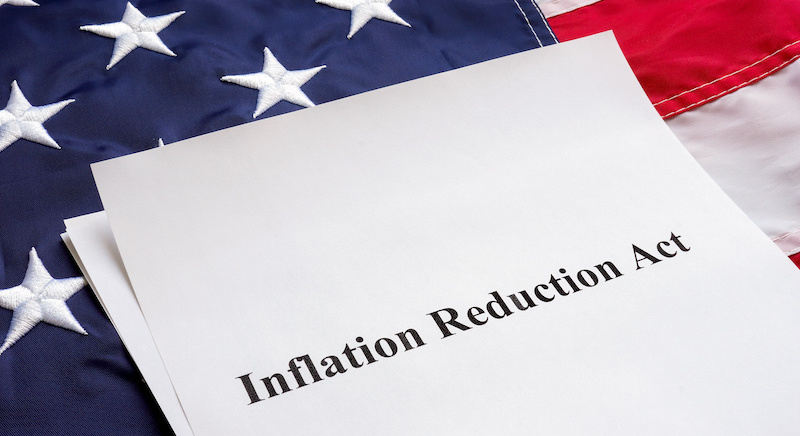Inflation Reduction Act (IRA) of 2022
What it Means for Individual Taxpayers
August 18, 2022
On Tuesday, August 16, 2022, President Biden signed the Inflation Reduction Act (IRA) of 2022 into law. This bill, which is designed to reduce the deficit and lower inflation while investing in domestic energy production and lowering healthcare drug costs, includes several key revenue-raising tax provisions.
The bill also includes several green energy and environmental tax credits, representing America’s largest investment in climate and energy initiatives. As a result, there is hope that its passage will spur many individual taxpayers to take advantage of various new tax credits and opportunities, whether when buying a new car or making improvements to a home. While most of these tax changes will impact tax planning for 2023 and beyond, some changes may also impact 2022 year-end tax planning.
Highlights of the major individual taxpayer-related items from the bill include:
Enhanced Tax Credits for the Purchas of New or Previously Owned Electric Vehicles
For electric vehicles that are placed into service after December 31, 2022, the IRA will extend the previous tax credit of up to $7,500 for 10 years—until December 2032. The amount of the credit will now be based on a calculation that considers factors like the vehicle’s sourcing and assembly. The most important provision is that the final assembly of the vehicle must be completed in North America.
There are certain electric vehicles that would have limited or possibly no credit available, so the credit will not be evenly applied to all vehicles. By the end of the year, the IRS will be required to publish a list of the eligible vehicles and the amount of the credit.
Additionally, used electric vehicles will now have a separate tax credit of either up to $4,000 or 30% of the price of the vehicle, whichever is less. One stipulation on this credit is that a used electric vehicle that is purchased for resale will not qualify for this credit. Also, for the purposes of this provision, a used vehicle is defined as a model year that’s at least two years older than the calendar year the vehicle is acquired by the taxpayer.
Starting in 2024, the buyer of these electric vehicles will have the option to use the credit as a discount upon purchase of the vehicle. If they choose to do so, the buyer will be able to take advantage of the credit by way of a reduced sales price instead of having to wait until tax filing season to claim the credit.
The price and the type of the vehicles are becoming increasingly more important:
- Vans, trucks, and SUVs with an MSRP of greater than $80,000 will no longer be eligible for these vehicle credits.
- For cars, the MSRP must be below $55,000.
- For used vehicles (considered to be at least two years old for the purpose of the credit), the purchase only qualifies for this tax credit if the cost is $25,000 or less.
Taxpayer modified adjusted gross income (MAGI) is now used to determine the eligibility for the credit. Individuals with MAGI greater than $150,000 are not eligible for these credits. The threshold for married filing joint taxpayers is $300,000 and $225,000 for head of household filers.
- Individuals who are looking at an electric car but would be excluded from the credit due to their income should consider purchasing before the end of 2022 before the income limits come into effect.
If you had a written, binding purchase contract in place by August 16, 2022 for a qualifying vehicle that will not be delivered until 2023 due to supply chain restrictions, that vehicle is eligible for the old tax credits prior to the new law.
Enhanced Tax Credits and Rebates for Energy-Related Home Improvements
Energy Efficiency Home Improvements
- The now expired credits were worth 10% of the costs of installing certain energy-efficient insulation, windows, doors, roofing, and similar energy-saving improvements in your home. You could previously also claim the credit for 100% of the costs associated with installing certain energy-efficient water heaters, heat pumps, central air conditioning systems, furnaces, hot water boilers, and air circulating fans. However, there was lifetime limit of $500 for the credit, meaning that all prior year credit amounts counted against the $500.
- Starting in 2023, the newly revised credit will be increased to 30% of the cost and the $500 lifetime limit will be replaced by a $1,200 annual limit.
Residential Solar Tax Credits
- Now under a new name, the credits for installing qualifying systems that use solar, wind, geothermal, biomass or fuel cell power to produce electricity, heat water or regulate the temperature in your home have been increased from 26% of the cost to 30% for 2022-2032.
- The credit will then be reduced to 26% in 2033 and 22% in 2034 before expiring.
Rebates for New Technologies in Homes
- Rebates are available to many households for improvements such as new heat pumps, heat pump water heaters, electric ranges, electric ovens, electric dryers, electrical panels, wiring, and air duct sealing.
- Credits range from $840 to $8,000 depending on the work performed.
- Households at less than 80% of an area’s median income qualify for 100% of the allowable credits and households between 80% and 150% get 50% of the allowable credit, with no credit allowed for those with higher incomes. (Note: The IRS has not yet provided guidance on how to determine median incomes.)
Extension of access to federal subsidies under the Affordable Care Act
The bill extends access to federal subsidies under the Affordable Care Act through 2025 for many who get their health insurance through the Marketplace. Previously, these additional subsidies were set to sunset at the end of 2022.
Under these extensions, there is no longer the cutoff from receiving the Premium Tax credit if your household is over 400% of the Federal Poverty Limit. The cost of the Silver Plan has been capped at 8.5% of an individual’s income.
For lower income households, the subsidies and Premium Tax Credit will continue to be more generous, as well.
Increased IRS Funding
Increased IRS funding by $78.9 billion
- $45.6 billion to Enforcement. This allocation is made up of money used to hire more enforcement agents, providing legal support, and investing in investigative technology.
- $25.3 billion to operations support
- $3.2 billion to taxpayer services. Ex. filing and account services, prefiling assistance, and education
- $4.8 billion to business systems modernization
While there has been much talk of how this added support may lead to additional audits of taxpayers, it is important to note that much of funding will go to replacing the nearly 50,000 employees who will be retiring within the next ten years. The IRS and Treasury Department have also indicated that audit rates will not go up for businesses and individuals making $400,000 or less.
15% Corporate Minimum Tax
15% Corporate Minimum Tax for large corporations with $1 billion or more in financial statement revenue.
1% Excise Tax on Stock Buybacks
1% excise tax on stock buybacks by certain domestic publicly traded corporations. Applicable to buybacks occurring after December 31, 2022.
We will continue to provide updates as additional information becomes available. Should you have any questions on how the IRA may impact you and your tax situation, please contact your HBE advisor.




